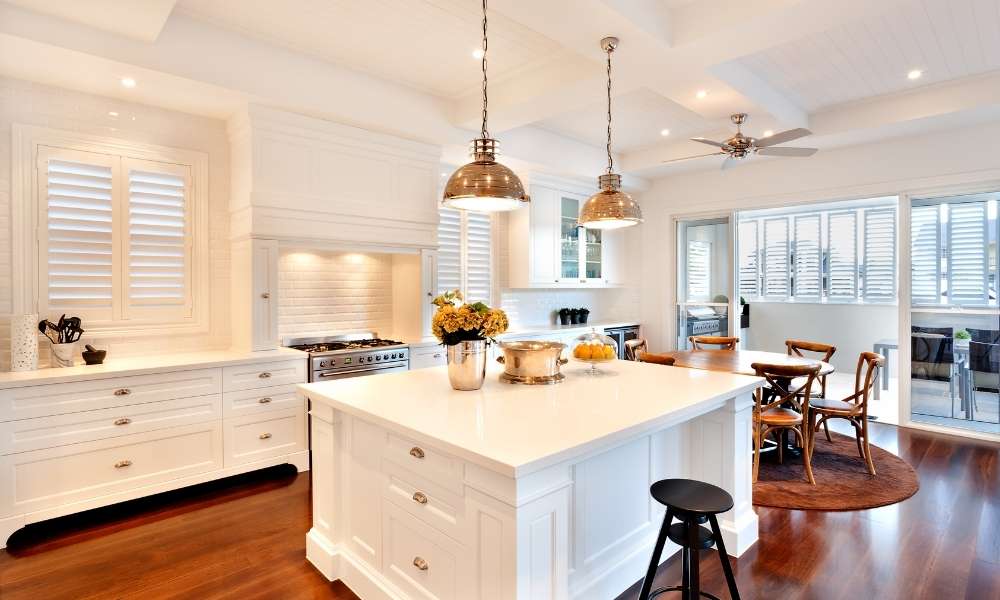Paint kitchen cabinets without sanding by using a primer and paint with a low-VOC content. First, remove all of the cabinet hardware and clean the surfaces with a degreaser. Apply a coat of primer to all of the surfaces and let it dry. Then, apply two coats of paint, allowing each coat to dry completely before applying the next.
The Advantage of Painting Kitchen Cabinets Without Sanding

When painting your kitchen cabinets, you have the option of whether to sand them down or not. For some people, sanding is a necessary step to achieve a smooth finish. However, for others, it’s an unnecessary step that can be skipped without any consequences. If you’re looking to save time and effort, then painting your kitchen cabinets without sanding is the way to go.
Here are a few tips on how to do it:
1. Make sure that your cabinets are clean and free of dust and dirt before you start painting. This will help ensure a smooth finish.
2. Apply a coat of primer to your cabinets before painting them. This will help the paint adhere better and create a smoother finish.
3. Use high-quality paint in order to get the best results.
What kind of paint to use and how to apply it

If you’re looking to give your kitchen cabinets a fresh look, painting them might be the way to go. But before you start slapping paint on their willy-nilly, you need to know what kind of paint to use and how to apply it.
There are a few different types of paint that can be used on kitchen cabinets: latex, enamel, and oil-based. Latex paint is the most common type of paint and it’s easy to use; it’s also
environmentally friendly. Enamel paint is more durable than latex and can be used on surfaces that are exposed to moisture or heat, such as cabinets in the kitchen or bathroom. Oil-based paint is the most durable type of paint but it’s also the most difficult to use; it’s not environmentally friendly and can take a long time to dry.
Paint your kitchen cabinets without sanding using a few simple steps.

If you’re looking to update your kitchen cabinets without spending a lot of time or money, you can paint them without sanding. Here are a few simple steps to get the job done:
1. Remove all of the cabinet hardware and set it aside.
2. Wash the cabinets with a degreaser and allow them to dry completely.
3. Apply a coat of primer to the cabinets and allow it to dry completely.
4. Paint the cabinets with quality latex paint in your desired color and allow it to dry completely.
5. Reattach the cabinet hardware using the original screws.
Clean the cabinet

Are your kitchen cabinets in need of a makeover but you don’t have the time or energy to sand them down first? Here’s a simple way to paint kitchen cabinets without sanding—all you need is a few supplies and some patience.
First, remove all of the cabinet doors and hardware and set them aside. Next, using a degreaser, clean the surfaces of the cabinets thoroughly. Once they are dry, apply a coat of primer to all surfaces. After the primer has dried, apply two coats of paint in your desired color. Finally, reattach the doors and hardware and you’re done!
Apply primer
Priming kitchen cabinets before painting is key to a successful paint job. The primer will seal the wood and help the paint stick, preventing it from peeling or chipping. Here’s how to apply primer to your kitchen cabinets without sanding:
1. Remove all of the cabinet doors and hardware, and set them aside.
2. Wash the cabinet surfaces with a degreasing agent, such as TSP or trisodium phosphate. This will remove any oils or residue that might interfere with the primer’s adhesion.
3. Allow the cabinets to dry completely.
4. Apply a coat of primer to each cabinet surface with a brush or roller. Be sure to get into all of the nooks and crannies, and allow enough time for the primer to dry completely before moving on to the next step.
Apply primer to all surfaces of the cabinet

The primer should be applied to all surfaces of the cabinet, even if it is going to be painted a different color. This will help the paint adhere better and will make it last longer. If the cabinets are in good condition, a light coat of primer may be all that is needed. If there are any areas that are damaged or have been previously painted, then a heavier coat of primer should be applied.
Paint the cabinets

Paint the cabinets to give your kitchen a fresh, new look. You can do this without sanding by following these simple steps.
First, remove all of the cabinet doors and hardware. Next, use a deglosser or liquid sandpaper to remove any existing finish and debris. Once this is done, clean the surface with a damp cloth. Then, apply a coat of primer to the cabinets. Finally, paint them with your desired color.
Draw the cabinets using a brush or roller

When you’re painting your kitchen cabinets, there are a few ways to go about it. You can use a brush, roller, or spray gun. The method you choose will depend on the finish you want and how much time you want to spend on the project.
If you’re looking for a quick and easy way to get a smooth finish, using a brush or roller is the way to go. However, if you want a more polished look, using a spray gun will give you better results.
No matter which method you choose, be sure to start by cleaning the cabinets thoroughly. This will ensure that the paint adheres properly and gives you a good finish. If painting over an existing coat of paint, make sure all the surfaces are sanded smooth first.
Once everything is ready, start by painting the door frames first.
Be sure to paint even in strokes and use a light coating of paint

The best way to paint kitchen cabinets without sanding is to use a light coating of paint and to be sure to paint even in strokes. This will ensure that the cabinets are covered evenly and that there are no streaks or missed spots. Make sure to also let the first coat of paint dry completely before applying a second coat.
Let dry
If your kitchen cabinets are in good condition, you don’t have to sand them before painting. In fact, if you do, you may end up with a less-than-professional finish. Here’s how to paint kitchen cabinets without sanding:
1. Remove all cabinet hardware and thoroughly clean the cabinets with a degreaser or a TSP substitute.
2. Tape off the edges of the cabinet boxes and doors with painter’s tape.
3. Apply a coat of primer to the cabinets and doors, using a brush or roller. Be sure to get into all the nooks and crannies. Let the primer dry completely.
4. Apply a coat of paint to the cabinets and doors, using a brush or roller. Again, be sure to get into all the nooks and crannies. Let the paint dry completely.
Allow the paint to dry for at least four hours before proceeding to the next step
It is important to allow the paint to dry for at least four hours before proceeding to the next step. This will ensure that the paint will not chip or peel off. Paint can take up to 24 hours to completely dry, so be patient and wait until the paint is completely dry before moving on to the next step.
Apply a second coat of paint
When repainting cabinets, it is important to apply a second coat of paint to ensure even coverage and hide any brush strokes. After the first coat has dried, wait at least two hours before applying the second coat. Use a synthetic bristle brush for even application and to avoid leaving brush strokes. If you are painting over a dark color, be sure to use a primer first to ensure good coverage.
Conclusion
Now that you know how to paint kitchen cabinets without sanding, it is time to get started on your project. The first step is to gather the supplies that you will need. This includes a primer, paint, a brush or roller, and a rag.
Once you have gathered your supplies, it is time to start painting. Begin by priming the cabinets with the primer. Once the primer has dried, apply two coats of paint to the cabinets. Be sure to allow sufficient drying time between coats.
Once the paint has dried, it is time to seal it with a coat of polyurethane. This will help protect the paint from scratches and chips. Allow the polyurethane to dry completely before putting your cabinets back in use.





